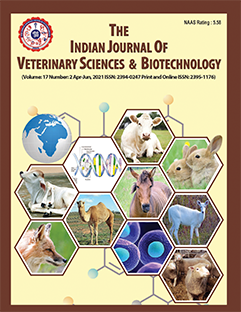Management of Dystocia in Dromedary Camel through Fetotomy
DOI:
https://doi.org/10.48165/Keywords:
Dystocia, significant, reproductive, severeAbstract
Dystocia, or difficult birth, is a significant reproductive concern in animals, often leading to severe complications for both the dam and the fetus. Although camels are known for their relatively low incidence of dystocia compared to other livestock; dystocia in camels, particularly dromedaries, has been sporadically reported, and are attributed to both fetal and maternal causes (Gera and Datt, 1981; Purohit et al., 2000). Dystocia in camelids is uncommon, but the long neck and fetal limbs make them more prone to flexion deformities, which are frequent causes of dystocia (Purohit, 2012). Tibary et al. (2008) projected that around 5% of all camelid deliveries will necessitate some form of assistance, with nearly 2% requiring specialized obstetrical intervention. Similarly, Aboul-Fadle et al. (1990) reported a 9% incidence of dystocia in camels. Dystocia should be suspected in camels if the first stage of labour extends beyond 6 h, accompanied by rising pain or discomfort, or if the second stage fails to progress as expected (Noakes et al., 2019). Fetal causes, such as limb flexion and lateral deviation of the head and neck in anterior presentation, accounted for 54.54% and 36.36% of all fetal-related dystocia cases, respectively (Purohit et al., 2011). Epidural anaesthesia, typically with 5-10 mL of 2% lignocaine, is recommended for pain management. If the cervix is only partially dilated, a Cesarean section should be considered as an alternative (Thangamani et al., 2018). Additionally, sufficient space in the birth canal is necessary for the fetotomy, and proper restraint of the animal is essential for a safe and effective procedure (Schultz et al., 2008). This report documents the successful management of dystocia in a dromedary camel through fetotomy.
Downloads
References
1. Aboul-Fadle, W., Bolbol, A., Al-Eknah, M.M., Bendari, M., & Elgasnawy, Y. (1990). Caesarean section in she-camels. Proceedings of 4th Science Congress, Faculty of Veterinary Medicine, Assiut University, 2, 366–369.
2. Gera, K.L., & Dutt, S.C. (1981). Fetal dystocia in a she camel: A case report. Indian Veterinary Journal, 58, 64–65.
3. Kumar, P., Purohit, G.N., & Mehta, J.S. (2012). Dystocia in a camel and its correction with fetotomy – A case report. Journal of Camel Practice and Research, 19(2), 289–290.
4. Noakes, D.E., Parkinson, T.J., & England, G.C.W. (2019). Veterinary Reproduction and Obstetrics (10th ed.). Elsevier Co. Ltd.
5. Purohit, G.N. (2012). Dystocia in camelids: The causes and approaches of management. Open Journal of Animal Science, 2, 99–105.
6. Purohit, G.N., Gupta, K.A., Gupta, A.K., Garg, N., Vyas, K., Pareek, P.K., & Sharma, S.S. (2000). Caesarean section in a dromedary camel: A case report. Indian Journal of Animal Reproduction, 15, 197–199.
7. Purohit, G.N., Mehta, J.S., Dholpuria, S., Kumar, P., Yadav, S.P., & Shekher, C. (2011). Dystocia in dromedary camels: Handling and outcome of fourteen cases. Theriogenology Insight, 1, 15–23.
8. Schultz, L., Tyler, J., Moll, H., & Constantinescu, G.M. (2008). Surgical approaches for cesarean section in cattle. Canadian Veterinary Journal, 49, 565–568.
9. Thangamani, A., Srinivas, M., & Prasad, B.C. (2018). Obstetrical operation and epidural analgesia in domestic animals – An overview. Journal of Veterinary Science & Technology, 7(2), 10–15.
10. Tibary, A., & Anouassi, A. (1997). Obstetrics and neonatal care. In Tibary, A. (Ed.), Theriogenology in Camelidae. Abu Dhabi Printing Press, Mina.
11. Tibary, A., Rodriguez, J., & Sandoval, S. (2008). Reproductive emergencies in camelids. Theriogenology, 70, 515–534.
Downloads
Published
Issue
Section
License
Copyright (c) 2025 Indian Journal of Veterinary Sciences and Biotechnology

This work is licensed under a Creative Commons Attribution-NonCommercial-NoDerivatives 4.0 International License.




